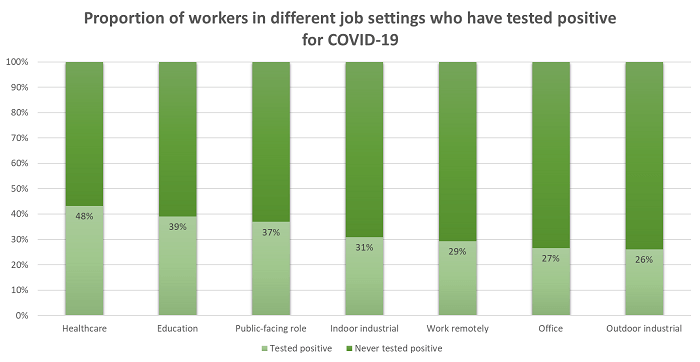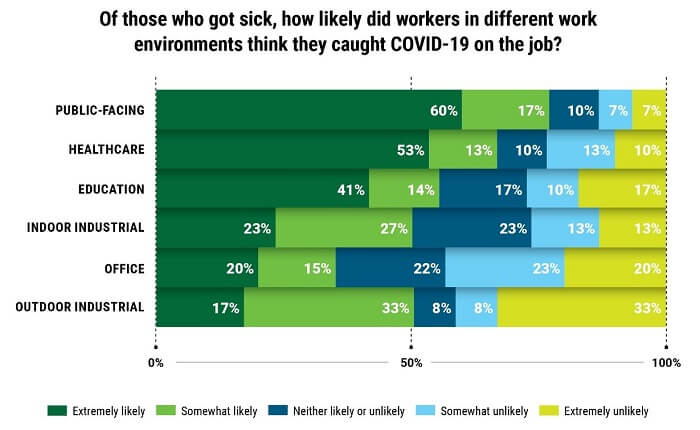The majority of educators also reported they were extremely or somewhat likely to have gotten sick at work. In open-ended responses, many educators cited working with children who were unable to be vaccinated yet as a contributing factor to their workplace COVID-19 risk.
The perceived likelihood is lower for those who work in indoor industrial settings, but lower still for those who work in offices or outdoor industrial settings. In general, indoor industrial work is more likely than office work to involve shared machinery and workspaces, full-time in-person work arrangements, and movement of workers around the facility, all of which contribute to a higher risk of close contact between workers. By comparison, office workers often reported there were very few people in their office on any given day due to hybrid schedules, that every office worker has their own separate workspace away from others, and high compliance with masking policies, all of which contributed to their feelings about workplace COVID-19 safety.
While workers in outdoor industrial settings may face the lowest baseline risk of airborne transmission on the job, their workdays often aren’t entirely free of close contact, such as in shared break areas, vehicles, an office headquarters, or during training. These workers were most likely to report they were extremely unlikely to have caught COVID-19 on the job, but were also most likely to respond “somewhat likely,” which indicates that the cause of transmission wasn’t absolutely clear. This could be due in part to the infrequency of workplace testing in industries with open worksites, and thus more uncertainty about where and to whom workers might have been exposed.
Job Role: Managers, Supervisors Tend to Feel Safer than People who Report to Them
By job role, people in executive and managerial roles reported feeling safer at work than those in non-managerial roles. For example, 88% of chief executives polled felt “very safe” from COVID-19 at work, and managers across all industries were most likely to feel “very safe1,” with the exception of food service and medical and health services managers, most of whom felt “somewhat safe.2”
By contrast, in non-managerial roles, 31% of teachers3, 26% of retail cashiers and salespeople4, and 26% of frontline nurses5 reported feeling somewhat or very unsafe, more so than the people in supervisory roles over these positions. In general, non-managers reported more frequent interaction with others and close contact being primary contributing factors to their assessment of COVID-19 risk at work.
Healthcare workers who work in close proximity to patients are generally at higher risk of workplace infectious disease transmission, but the pandemic has brought many of them into close contact with an unprecedented number of contagious individuals. The same can be said of people in public-facing roles, where workplaces that were once relatively safe have become a significant risk to workers every day on the job.


